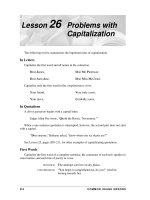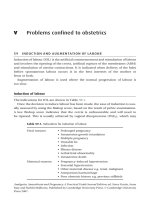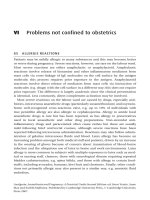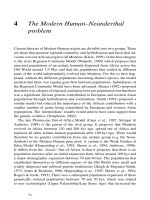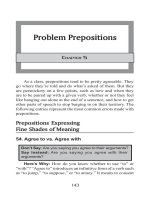chinas population problem
Bạn đang xem bản rút gọn của tài liệu. Xem và tải ngay bản đầy đủ của tài liệu tại đây (33.97 KB, 3 trang )
China's Population ProblemThe Chinese government has taken the
enforcement of family planning and birthrate laws to an extreme by
violating the civil rights of its citizens, which has had bad effects on the
morale of its people (Whyte 161). China's population has grown to such
an enormous size that it has become a problem to both the people and
government. China, the most populous country in the world, has an
estimated population of about one thousand-one hundred-thirty three
point six million (Hsu 1). Ninety-four percent of the population thrives in
the eastern half of China, which composes about forty-three percent of
China's total area (Hsu 1). The eastern half of China contains its most
populous cities like Beijing, Shanghai, and Tianjin. However these cities
have a low fertility rate due to recent bandwagons of birth control. The
average density in the eastern half of China averages around
two-hundred and thirty-six people per square kilometer, whereas the
density in the west half averages around ten point six people per square
kilometer (Hsu 1). Current enforcement of Chinese laws prevents
migration between provinces without proper authorization, as the citizens
in the west half of China have a desire to live in a more urban life where
jobs can be found easier, and the citizens in the more populous eastern
half have a stronger desire to live in the more rural western China (Hsu
4).The Chinese have always had a large population (Hsu 1). Even in
ancient times where the population would never fall below sixty million
(Hsu 1). Later, in the eighteenth century the population rose exceedingly
and China became the strongest and most economically wealthy (Hsu 1).
By the time the Qing Dynasty ruled, the fertile people of China had
reached a population of three-hundred million (Hsu 1). The birthrate in
China did decline in the nineteen-fifties due to campaigning by the
government on birth control (Hsu 1). However, after the population
decreased the government turned their attention to other matters while
the population slowly crept up again. Once again in the
nineteen-seventies the population became an issue and it received the
governments full attention. In order that the government might resolve
this problem, the "Wan Xi Shao" policy, or the "marry later, give longer
spacing between children, and have fewer children" policy began to be
enforced (Hsu 2). This policy proved to have some effect but it did not
stop the fertile people of China, and the population has steadily risen to
the current population (Hsu 2). The recent laws imposed on the people of
China include the "One child per family law"(Hsu 2). This law began to be
enforced in nineteen-seventy-nine, so that the government might achieve
its goal of reducing the rate of natural increase to five per thousand by
nineteen-eighty-five, and to zero by the year two-thousand(Hsu 2). The
immense population had become straining on the economy and
resources (Linden 1). Migration to less populous areas of China became
restricted so that the government might be able to control the population
more effectively and easily (Hsu 4). Currently, the "one child per family"
law still exist, but it has become more flexible, in that it allows a second
child but with a longer interval between the first (Hsu 2). Through the
health service programs across China, birth control pills, inter uterine
devices, condoms, diaphragms , foams, and jellies had been distributed
in a matter of time (C.Q.W.R. 1). The government made life easier for
those who chose to obey this law by offering incentives such as: paid
maternity leave, time off for breast feeding, free child care, free
contraceptives, and paid time off for abortions and sterilization (Ehrlich
205). Other rewards for obeying this law and not exceeding the limit
included better housing and educational opportunities for their children
(Ehrlich 205). Doctors "volunteered" their services to sterilize couples
who had finished childbearing, and doctors also provided free abortions
at local clinics and hospitals (Ehrlich 205). However the government has
encountered resistance in rural areas and this has led to many abuses,
and one of the reasons why the government has performed many
coerced abortions and sterilizations (C.Q.W.R. 1). The Chinese
government has committed brutal and unjustified acts against offenders
of the "one child" policy, and in general the enforcement of these laws
has taken the governments undivided attention (Ehrlich 205). Resistance
by traditional citizens who mainly live in less populous areas, have
received involuntary abortions and sterilizations. China has gone to great
lengths to control population, and it has involved reprogramming citizens
to have smaller families and to actively use family planning (Ehrlich 205).
Family planning and policies limiting the number of children in families
has received attention from many countries and issues like this requires
the governments full attention and prevents them from focusing on more
important affairs like scientific advancements and resolving poverty and
homelessness (Linden 2). China's family planning policies and children
limiting laws can be considered as reasonable and in the interest of the
people of China, but because the government takes the enforcement of
these laws to such an extreme shows that they have little consideration
for the Chinese citizens. Means of controlling population that infringe
upon a human beings civil rights have no place among laws and should
merely be taken as a suggestion by the Chinese citizens, and in no way
forced upon them.If China's population received no attention the
environment and ecosystem would not be able to with stand the force of
such an impact of an immense population (Linden 1). Numerous species
of animals would be put in danger due to the destruction of their homes
for housing needs, and some even driven to the verge of extinction
(Linden 1). Once lush green forests and jungles teaming with life would
be swarming with microbes, cockroaches, weeds, and rats, all of which
would thrive off of such conditions (Linden 1). The best and most
reasonable way to prevent the destruction of the environment and the
overuse natural resources involves the reduction of propagation by
nearly half (Linden 1). The Earth has encountered many problems over
the years with the environment and the ecosystem, many of which relate
proportionally to population size. The consideration of family planning
policies and laws remains feasible to most governments, however
inappropriate the people targeted might deem them. A governments
position on a subject has not always proven to have justice in the favor of
its people, but in the long run proves beneficial most of the time. History
has shown that previous attempts to control population have failed and
recent laws enforced appear to be taken to extremes by the government.
However primitive their ways of accomplishing this have shown to be, it
must not be overlooked that it has proved effective in reducing China's
immense population. Works Cited1. "Congressional Quarterly Weekly
Report" (C. Q. W. R.), June 5, 1993.2. Ehrlich, Paul R. The population
explosion, Simon and Schauster, New York, 1990.3. Hsu, Mei-Ling,
"Population of China: Large is not beautiful" Focus Spring 1992: vol.
42, no.1.4. Linden, Eugene. "Too Many People" Times fall 1992: vol.
140, issue 27, p. 64.5. Whyte, Martin King, Urban Life in Contemporary
China, The University of Chicago press, Chicago, 1984.

